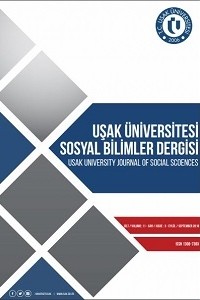Siirt İlindeki Ortaöğretim Öğrencilerinin Sayısal Okuryazarlık Düzeylerinin Cinsiyet, Sınıf ve Öğrenim Gördüğü Lise Türüne Göre Farklılaşmasının İncelenmesi
İçerisinde bulunduğumuz 21 yüzyıl ya da bilgi çağı olarak tanımlanan yüzyılda bilgisayar okuryazarı, bilgi okuryazarlığı, teknoloji okuryazarlığı, medya okuryazarlığı diğer bir ifade ile sayısal okuryazarlık becerilerine sahip bireylerin yetiştirilmesi oldukça önemlidir. Bu çalışmada; ortaöğretim öğrencilerinin sayısal okuryazarlık becerileri düzeylerinin ortaya konulması amacıyla gerçekleştirilmiştir. Bu amaçla ortaöğretim öğrencilerinin bilgisayar okuryazarlığı, bilgi okuryazarlığı, teknoloji okuryazarlığı ve medya okuryazarlığı becerilerinin cinsiyet, sınıf ve öğrenim gördüğü lise türü değişkenlerine göre incelenmiştir. Çalışmanın evrenini Siirt il merkezde bulunan ortaöğretim okulları örneklemi ise Siirt il merkezde bulunan ortaöğretim okullarında öğrenim gören toplam 548 ortaöğretim öğrencisi oluşturmaktadır. Çalışmada veri toplama aracı olarak Kıyıcı (2008) tarafından geliştirilen “sayısal okuryazarlığı belirleme ölçeği” kullanılmıştır. Elde edilen verilerin çözümlenmesinde aritmetik ortalama, standart sapma, bağımsız örneklem t testi ve varyans analizinden yararlanılmıştır. Çalışma sonucunda; ortaöğretim öğrencilerinin sayısal okuryazarlığı düzeylerinin orta seviyenin üstünde olduğu, cinsiyet ve öğrenim gördüğü lise türü değişkenlerine göre bazı okuryazarlık alt boyutlarında anlamlı bir farklılaşmanın olduğu tespit edilmiştir.
Anahtar Kelimeler:
Bilgi okuryazarlığı, bilgisayar okuryazarlığı, medya okuryazarlığı, sayısal okuryazarlık, teknoloji okuryazarlığı
An Investigation into High School Students’ Digital Literacy Level
We live in a 21st century world in which advances in technology have almost become a daily routine, so it is inevitable that people from all walks of life are greatly affected by these changes. Parallel to these developments, societies need education systems to prepare students who *are* better equipped to deal with challenges of learning and those of knowledge dissemination in an age of information and technology. With the advances1 in technology occurring with the blink of an eye, students’ competence in digital literacy and related concepts such as computer, information, media and technological literacy should come to the fore for researchers interested in these literacy roles in schools. To help prepare students for an increasingly information-based world, developing students' literacy should be a major objective of the curriculum researchers. This study aims to explore high school students’ digital literacy level which also encompasses information, computer, technological, information and media literacy. In order to determine high school students’ digital literacy level, this study used an instrument developed by Kıyıcı (2008). Independent variables such as students’ gender, grade level and school type were considered in order to determine if there is any significant difference between those variables and students’ digital literacy level. The sample is comprised of students who are selected from five high schools in the city of Siirt. Survey model is employed in this study. Sampling method adopted for the study is cluster random sampling which includes 548 high school students. At the end of our analyses, it was found that while there is a significant difference between students’ gender, grade level and their digital literacy, technological literacy, media literacy, information literacy; results show no significant difference between school type and all of this literacy included in the study.
Keywords:
computer literacy, digital literacy, information literacy, media literacy, technological literacy.,
- ISSN: 1308-738X
- Başlangıç: 2015
- Yayıncı: Uşak Üniversitesi
Sayıdaki Diğer Makaleler
Sınıf Öğretmenlerinin Özel Alan Yeterliklerine İlişkin Görüşleri (Kilis İli Örneği)
Yunus Emre AVCI, Mustafa CİNOĞLU
Öğretmen Yetiştirmede Mevcut Tarihi Birikimimiz Ve Model Arayışları Sürecinde Bir Model Önerisi
English As A Langua Franca: Practices Of Academics in A Turkish University
Feden AKKOÇ, Durmuş Koç Fidan AKKOÇ
Karar Vermede Oyun Teorisi Tekniği Ve Bir Uygulama
Kavram Karikatürleri ve Hayat Bilgisi Derslerinde Kullanımı
Hakan DÜNDAR, Merve Lütfiye ŞENTÜRK
The Role of Civil Society in Preventing Global Poverty
